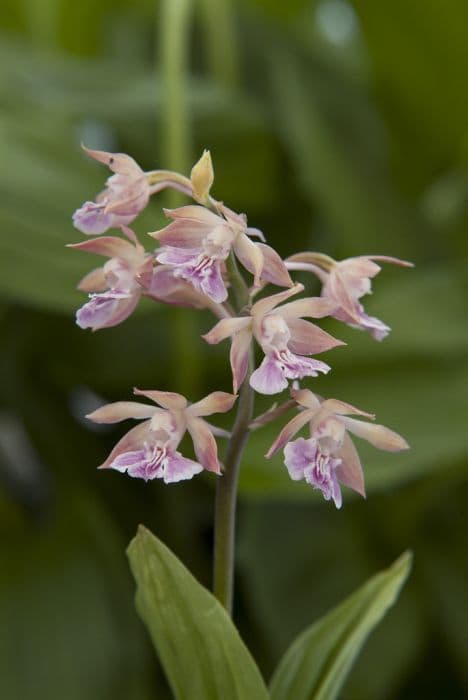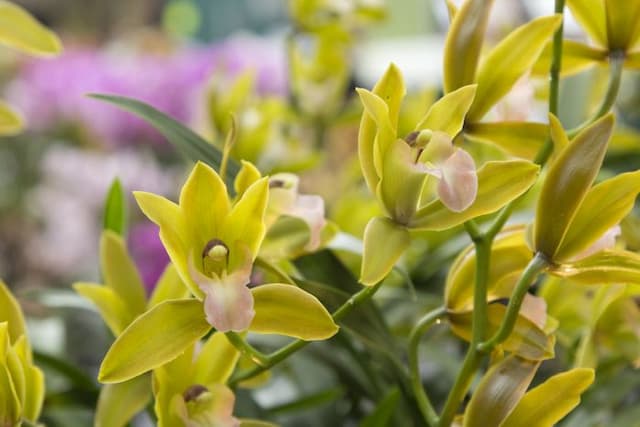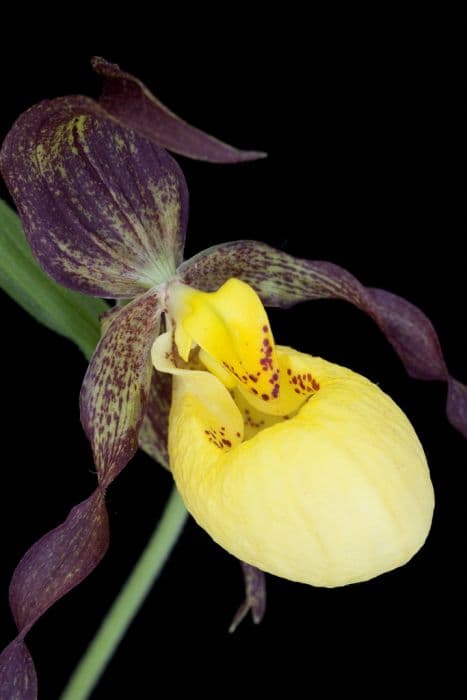Taiwan pleione Pleione formosana

ABOUT
The Taiwanese Pleione, known for its exquisite beauty, is a terrestrial plant that primarily blooms in the spring. The foliage comprises narrow, elongated, pleated leaves that emerge mainly after flowering. These leaves are typically arranged in a fan-like fashion giving the plant a textured and dynamic appearance. The most striking feature of the Taiwanese Pleione is its flowers. Each bloom is a remarkable spectacle, typically composed of a single flower per stem, though occasionally you may see multiple. The flowers are notably large and showy with a range of colors from pure white and various shades of pink to deep purples. Some flowers are adorned with striking patterns and spots, which along with their colors, contribute to their ornamental appeal. The petals and sepals spread outwards and upwards, sometimes with a gentle twist, giving the flowers a delicate, poised form. In contrast, the lip, which is the most prominent part of the orchid flower, is significantly larger than the other segments and often features a different, more intense color or pattern. This lip is typically fringed or ruffled, adding to the flower's intricacy and charm. The Taiwanese Pleione's blooms carry an enchanting, subtle fragrance that is most noticeable on warm, sunny days when the scent can gently perfumes the air. Overall, the plant's presentation, with its enchanting blooms and gracefully arranged leaves, creates an alluring and refined display, highly valued among orchid enthusiasts and gardeners seeking unique and eye-catching plants for their collections.
About this plant
 Names
NamesSynonyms
Windowsill Orchid, Taiwanese Pleione, Formosa Pleione
Common names
Coelogyne formosana, Epidendrum formosanum, Pleione formosana var. davidii, Pleione formosana var. dayanensis, Pleione formosana var. formosana, Pleione formosana var. pumila, Pleione hookeriana, Pleione limprichtii, Pleione lobbii, Pleione speciosa, Pleione wallichiana.
 Toxicity
ToxicityTo humans
Taiwan pleione, Pleione formosana, is not commonly known to be toxic to humans. There are no well-documented reports of poisoning or toxic reactions from ingesting or handling this plant. However, as with any non-food plant, cautious handling and avoidance of ingestion is generally recommended.
To pets
Taiwan pleione isn't widely recognized as a toxic plant for pets. There's a lack of specific information regarding its toxicity to dogs, cats, and other household animals. Since comprehensive toxicity data for pets is not readily available, it is prudent to prevent pets from ingesting this plant as a precaution. If your pet does ingest Taiwan pleione and you notice any signs of illness, consult a veterinarian.
 Characteristics
CharacteristicsLife cycle
Perennials
Foliage type
Deciduous
Color of leaves
Green
Flower color
Pink
Height
1 foot (30 cm)
Spread
1 foot (30 cm)
Plant type
Bulb
Hardiness zones
9
Native area
Asia
Benefits
 General Benefits
General Benefits- Ornamental value: Pleione formosana, commonly known as the Taiwan pleione, is prized for its beautiful, delicate flowers, which can add aesthetic appeal to gardens and homes.
- Easy to cultivate: This plant is fairly easy to grow and propagate, making it a good choice for novice gardeners or those with limited horticultural experience.
- Seasonal interest: The Taiwan pleione blooms primarily in the spring, providing seasonal color and visual interest to the environment.
- Compact size: Being a small, terrestrial orchid, it does not require much space, making it suitable for container gardening or small gardens.
- Conservation: Cultivating Taiwan pleione can contribute to the preservation of this species, as it faces threats in its natural habitat.
 Medical Properties
Medical PropertiesThis plant is not used for medical purposes.
 Air-purifying Qualities
Air-purifying QualitiesThis plant is not specifically known for air purifying qualities.
 Other Uses
Other Uses- Pleione formosana bulbs can be used as a natural adhesive. The sticky juice from the bulbs can act as a mild glue for paper or small crafts.
- The plant's large, showy flowers make it an excellent candidate for use in corsages and floral arrangements, adding exotic appeal to special occasions.
- The succulent pseudobulbs of Pleione formosana can serve as a hydration source. While not commonly used for this purpose, they can retain water and could hypothetically provide moisture in an emergency survival situation.
- Enthusiasts of the Pleione formosana could engage in botanical illustration, using the distinct blooms as subjects for drawing, painting, or photography, which promotes artistry and plant appreciation.
- The plant might be used in educational settings, such as botany classes, to teach students about orchid care, reproduction, and propagation techniques.
- Due to the unique nature of the orchid, it could be used as a living symbol in events, representing themes of beauty, rarity, and resilience.
- The orchid can be grown as a collector's item, where rare and unusual variants of Pleione formosana are sought after by hobbyists and orchid enthusiasts.
- As the flowers of Pleione formosana are short-lived, they are sometimes used to illustrate the concept of impermanence in philosophical or spiritual discussions.
- Innovative chefs could use the edible flowers of Pleione formosana as subtle decorative elements on high-end culinary dishes, highlighting both flavor and visual aesthetic (always ensuring that flowers are free of pesticides and safe for consumption).
- Pleione formosana can be cultivated for participating in orchid competitions and exhibitions, which fosters community among growers and provides a platform for sharing growing techniques and new cultivars.
Interesting Facts
 Feng Shui
Feng ShuiThe Taiwanese Pleione is not used in Feng Shui practice.
 Zodiac Sign Compitability
Zodiac Sign CompitabilityThe Taiwanese Pleione is not used in astrology practice.
 Plant Symbolism
Plant Symbolism- Rebirth: Pleione formosana, commonly known as the Taiwanese pleione or the windowsill orchid, often symbolizes rebirth due to its ability to return and bloom each year with renewed vibrancy.
- Beauty and refinement: As a delicate and ornate flower, the Taiwanese pleione is often associated with beauty and the idea of refined elegance, admired for its striking flowers that grace its natural habitat.
- Overcoming challenges: The growth of the Taiwanese pleione, typically in mountainous and rocky areas, represents the idea of resilience and overcoming difficult challenges.
 Water
WaterThe Taiwan Pleione, also known as the Windowsill Orchid, requires moderate watering during its growth period in spring and early summer. The plant should be watered approximately every 7 to 10 days, ensuring that the potting mix is moist but not waterlogged. Depending on the size of the pot and the environment's humidity, you might need about 4 to 8 ounces of water each time. During its dormant period in late summer to early winter, reduce watering to once a month, providing just enough water to keep the potting mix from completely drying out, approximately 2 to 4 ounces.
 Light
LightThe Taiwan Pleione thrives in bright, indirect light or dappled sunlight. Avoid direct sunlight as it can scorch the leaves. A north or east-facing windowsill is an ideal spot for this plant as it provides the moderate light conditions it prefers. If grown outdoors, a shaded spot that mimics a woodland setting is perfect.
 Temperature
TemperatureThe Taiwan Pleione enjoys cool to intermediate temperatures with a range of 50°F to 75°F being ideal for active growth. It can tolerate nighttime lows down to 40°F and should be protected from temperatures above 80°F. Provide proper ventilation to avoid excessive heat buildup which is detrimental to its health.
 Pruning
PruningPruning the Taiwan Pleione is not generally required for health or growth, but removing spent flower spikes and dead foliage will encourage a tidier plant and better growth the following season. This can be done after flowering or when the foliage naturally withers in the fall. This practice also helps in preventing disease and pests by removing potential hiding spots.
 Cleaning
CleaningAs needed
 Soil
SoilThe best soil mix for the Taiwan Pleione should be well-draining and moisture-retentive, consisting of loam, leaf mold, and perlite or pine bark. The ideal soil pH for Taiwan Pleione is slightly acidic, around pH 5.5 to 6.5.
 Repotting
RepottingTaiwan Pleione should be repotted annually, ideally in the spring when new growth commences after their dormant period.
 Humidity & Misting
Humidity & MistingThe Taiwan Pleione thrives best in high humidity levels, ideally around 70-80%, which is crucial for its growth and flowering.
 Suitable locations
Suitable locationsIndoor
Provide bright, indirect light and high humidity for the Taiwan Pleione.
Outdoor
Protect Taiwan Pleione from frost, in partial shade with good airflow.
Hardiness zone
9-10 USDA
 Life cycle
Life cycleThe Taiwan pleione begins its life cycle from a pseudobulb, which is a storage organ that allows the plant to survive winter dormancy. In spring, it produces a single leaf and a flower stalk bearing one to two orchid-like flowers. After flowering, the leaf continues to photosynthesize and store energy in a new pseudobulb that forms at the base. By late summer or fall, the leaf dies back, and the plant enters a period of dormancy with the newly formed pseudobulb overwintering. During winter dormancy, it requires a cool, dry environment to prepare for the next growth cycle. In the following spring, the cycle restarts, with the new pseudobulb sprouting its own leaf and flower as the previous year's pseudobulb withers away.
 Propogation
PropogationPropogation time
Spring to Summer
The most popular method for propagating the Taiwanese pleione, Pleione formosana, is through division, ideally performed in the spring just as the plant is emerging from dormancy. When the pseudobulbs, which are the swollen stem bases of the plant, start to show signs of growth and new roots are just beginning to form, it is the ideal time for division. Carefully separate the pseudobulbs, ensuring each division has at least one growth bud. Plant these divisions in well-draining potting mix, situating them so that the top of the pseudobulb is just above the soil surface. Water the new divisions sparingly at first to prevent rot, gradually increasing as the new growth establishes. This method is favored for its simplicity and effectiveness, allowing growers to multiply their collections of Taiwanese pleiones and share them with other enthusiasts.









